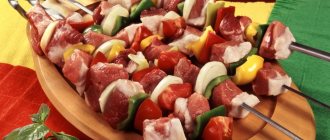Modern ovens resemble spaceship control panels in appearance and the number of different functions. Many of the provided modes remain unclear and are practically not used, but their presence directly affects the cost of the oven. If you constantly use an oven and love to cook in it, then what you definitely shouldn’t skimp on when choosing is convection in the oven.
If there are fan icons on the oven panel, it means the oven is operating in convection modes
First, let's look at the structure of ovens and the operating principle of convection.
What does it represent?
The phenomenon of convection is based on the expansion of colder substances upon contact with hot masses. In such circumstances, the heated substance loses density and becomes lighter compared to the cold space surrounding it. Most accurately, this characteristic of the phenomenon corresponds to the movement of heat flows when heating water.
The movement of molecules in opposite directions under the influence of heat is exactly what convection is based on. Radiation and thermal conductivity are similar processes, but primarily concern the transfer of thermal energy in solids.
Vivid examples of convection are the movement of warm air in the middle of a room with heating devices, when heated flows move to the ceiling, and cold air descends to the very surface of the floor. That is why, when the heating is on, the air at the top of the room is noticeably warmer compared to the lower part of the room.
Useful programs using convection
If you don’t know why convection is needed in an electric oven, then you will choose the unit based on power and the volume of the working area. This is an entirely correct approach, because the speed of heating and cooking depends on the power, and the volume determines the ability to cook on several levels. However, the presence of a fan expands the capabilities of the oven, and the electric oven receives the following functionality:
- Convection only. Provides a wide range of standard options, from defrosting food to baking dietary dishes. It will help warm up plates, dry berries and herbs.
- Moist convection. Water is poured into a special container with a steam generator. Steam can be distributed in different ways: directed towards the food or dispersed throughout the oven. Steam supply is controlled. In addition to cooking food, it is possible to warm them up, as well as sterilize jars and, for example, baby food bottles.
Source web-3.ru
- Convector and bottom heater. A good mode for making pie, pizza or bread.
- Low temperature mode. With its help, yeast dough is suitable, fermentation of yogurt and curdled milk will occur.
- With bottom heater and grill. The products are not just baked, but acquire a golden brown crust. It is convenient to cook frozen foods (including semi-finished products).
- With top heater and grill (turbo grill). This mode allows you to get an appetizing crust on a poultry carcass or piglet.
Source gados.ru
About the convector and its modes in the following video:
Archimedes' law and thermal expansion of physical bodies
To understand what natural convection is, it is enough to consider the process using the example of Archimedes’ law and the phenomenon of expansion of bodies under the influence of thermal radiation. So, according to the law, an increase in temperature necessarily leads to an increase in the volume of liquid. The liquid heated from below in containers rises higher, and moisture of higher density, accordingly, moves lower. If heated from above, more and less dense liquids will remain in their places, in which case the phenomenon will not occur.
Safety of installation and operation
All models of gas ovens have several systems that ensure safe operation. So, the door glazing is made multi-layered so that the scalding temperature does not reach the outer surface of the door. So that even a child looking through the “porthole” at a chicken rotating on a spit will not get burned. He will not be able to participate in controlling the oven and opening the door, thanks to the lock.
In addition, as mentioned above, heat is removed from the surface of the oven by an internal electric fan.
The control panel of a gas device is much simpler than that of an electric one. In addition to the timer (1), the panel contains a temperature regulator (2) and a mode switch (3). Power on indicator (4)
The gas supply is blocked automatically if:
- the burner goes out accidentally;
- a gas leak occurs;
- The pressure in the gas line drops.
To install a gas oven, you must invite a specialist. He will not only safely connect the gas, but will also check the compliance of the technical device with the type of gas (natural or liquefied) and, if necessary, replace the nozzle.
Additionally, it is necessary to install exhaust equipment. To connect to the electrical network and gas, you need to contact specialists.
The electrical outlet must be of the correct type and must be grounded. In addition to the above, it is necessary to take measures to ensure free access to the oven and its removal. Therefore, it is important to properly prepare the place.
The emergence of the concept
The term “convection” was first proposed by the English scientist William Pruit back in 1834. It was used to describe the movement of thermal masses in heated, moving liquids.
The first theoretical studies of the phenomenon of convection started only in 1916. During the experiments, it was found that the transition from diffusion to convection in liquids heated from below occurs when certain critical temperature values are reached. Later this value was defined as the “Roel number”. It was named after the researcher who studied it. The experimental results made it possible to explain the movement of heat flows under the influence of Archimedes' forces.
Types of convection
There are several types of the phenomenon we describe - natural and forced convection.
An example of the movement of hot and cold air flows in the middle of a room best characterizes the process of natural convection. As for forced, it can be observed when stirring a liquid with a spoon, pump or stirrer. Convection is not possible when heating solids. This is due to the rather strong mutual attraction during the vibration of their solid particles. As a result of heating bodies of solid structure, convection and radiation do not occur. Thermal conductivity replaces these phenomena in such bodies and promotes the transfer of thermal energy.
A separate type is the so-called capillary convection. The process occurs when the temperature changes as the liquid moves through the pipes. Under natural conditions, the significance of such convection, along with natural and forced ones, is extremely insignificant. However, in space technology, capillary convection, radiation and thermal conductivity of materials become very significant factors. Even the weakest convective movements in conditions of weightlessness lead to difficulties in the implementation of some technical problems.
Consumer Reviews
Before choosing one or another model, you should pay attention to the reviews.
Review of Zanussi ZLB 331:
More details on IRecommend:
Review of Gorenje BO7454DX:
More details on IRecommend:
Review of the VitekVT-2490W mini-oven:
More details on IRecommend:
Baked goods, juicy meat, grilled fish with vegetables, baked potatoes - all this is the merit of ovens and mini-ovens equipped with a fan. They make life easier for housewives and allow you to diversify the menu. It is worth noting that the prices for ovens and stoves with this function are not much higher than the cost of middle-class appliances without this function. On average, a stove will cost 25,000 rubles.
Oven dishes are tasty and healthy
If you have any questions, be sure to ask them in the comments. We'll be happy to answer them and help you choose the perfect appliances for your home.
Convection in layers of the earth's crust
Convection processes are inextricably linked with the natural formation of gaseous substances in the thickness of the earth's crust. The globe can be considered as a sphere consisting of several concentric layers. At the very center is a massive hot core, which is a high-density liquid mass containing iron, nickel, and other metals.
The surrounding layers for the earth's core are the lithosphere and semi-fluid mantle. The top layer of the globe is the earth's crust itself. The lithosphere is formed from individual plates that are in free motion, moving along the surface of the liquid mantle. During the uneven heating of different sections of the mantle and rocks, which differ in different composition and density, convective flows are formed. It is under the influence of such flows that the natural transformation of the ocean floor and the movement of bearing continents occur.
Differences between convection and conduction
Thermal conductivity should be understood as the ability of physical bodies to transfer heat through the movement of atomic and molecular compounds. Metals are excellent conductors of heat, since their molecules are in inextricable contact with each other. On the contrary, gaseous and volatile substances are poor conductors of heat.
How does convection occur? The physics of the process is based on heat transfer due to the free movement of a mass of substance molecules. In turn, thermal conductivity consists solely in the transfer of energy between the constituent particles of a physical body. However, both processes are impossible without the presence of particles of matter.
Examples of the phenomenon
The simplest and most understandable example of convection is the operation of an ordinary refrigerator.
The circulation of cooled freon gas through the pipes of the refrigeration chamber leads to a decrease in the temperature of the upper layers of air. Accordingly, being replaced by warmer currents, the cold ones fall down, thus cooling the products. The grille located on the rear panel of the refrigerator plays the role of an element that facilitates the removal of warm air formed in the compressor of the unit during gas compression. Lattice cooling is also based on convective mechanisms. It is for this reason that it is not recommended to clutter the space behind the refrigerator. After all, only in this case can cooling occur without difficulty.
Other examples of convection can be seen by observing natural phenomena such as wind movement. As air currents heat up over arid continents and cool over areas with harsher conditions, they begin to displace each other, causing them to move and transfer moisture and energy.
Convection is the basis for the soaring of birds and gliders. Less dense and warmer air masses with uneven heating at the Earth's surface lead to the formation of upward currents, which contributes to the process of soaring. To overcome maximum distances without expending effort and energy, birds need the ability to find such flows.
Good examples of convection are the formation of smoke in chimneys and volcanic craters. The upward movement of smoke is based on its higher temperature and lower density compared to the surrounding environment. As the smoke cools, it gradually settles into the lower layers of the atmosphere. It is for this reason that industrial pipes, through which harmful substances are released into the atmosphere, are made as high as possible.
How to use the option?
Detailed instructions for using the oven are included with each electric stove, but there are several rules that experts in household kitchen appliances recommend taking into account:
- The option does not require preheating the oven. Advance heating to a certain temperature may be required when preparing dishes that require this, for example, meringues, bread, soufflé.
- Using a convector means that baking and baking occurs at higher temperatures. Therefore, when setting the mode, you should make an adjustment of 20-25 degrees downward.
- When dishes occupy the entire usable area of the oven, the cooking time increases when the convector is turned on. This is due to the fact that there is no space for free air circulation.
- Different foods take different times to cook. Be sure to monitor this and remove the baking sheets before the dish burns.
- The convector allows you to cook frozen foods without defrosting. The main thing is to initially preheat the oven for 20-40 minutes.
If you follow these simple rules, using the option will be a pleasure.
How the convection mode is used in practice
In practice, the convector allows you to achieve amazing results. Thick pieces of meat and fish are baked with high quality and get an even crispy crust on all sides. The dish turns out moderately juicy. The mode significantly simplifies the process of preparing complex dishes, while saving energy consumption (gas or electricity).
The most common examples of convection in nature and technology
Among the simplest, easy-to-understand examples that can be observed in nature, everyday life and technology, the following should be highlighted:
- movement of air flows during operation of household heating batteries;
- formation and movement of clouds;
- the process of movement of wind, monsoons and breezes;
- displacement of tectonic earth plates;
- processes that lead to free gas formation.
Cooking food
Increasingly, the phenomenon of convection is realized in modern household appliances, in particular in ovens. A gas oven with convection allows you to cook different dishes simultaneously on separate levels at different temperatures. At the same time, mixing of tastes and smells is completely eliminated.
Air heating in a traditional oven relies on a single burner, which results in uneven heat distribution. Due to the targeted movement of hot air flows with the help of a specialized fan, dishes in a convection oven are more juicy and baked better. Such devices heat up faster, which reduces the time required for cooking.
Naturally, for housewives who cook in the oven only a few times a year, a household appliance with a convection function cannot be called an essential appliance. However, for those who cannot live without culinary experiments, such a device will become simply indispensable in the kitchen.
We hope that the presented material was useful to you. All the best!
Types of convectors
Even owners who have no doubt whether convection is needed in an electric oven do not always know that, technically, it can be implemented in different ways. Manufacturers offer the following technical solutions:
- Most often, in an electric oven you can see a fan of a simple design. Its power is enough to drive air throughout the volume.
- Some models have an additional heating circuit around the fan. This solution is more effective: the oven heats up and the dish cooks faster.
Source ferra.ru
- The wet (steam) convection function is convenient when the air is saturated with steam. The mode allows you to steam cook without frying at all; In addition, the dough rises better, and the dishes do not dry out and retain nutrients.
- Double convector. The oven has two fans. This solution allows for simultaneous cooking at different levels. If in models with one fan pies on two levels are cooked at different speeds (airflow is directed from above), then two convectors even out the processes.
The answer to the question of whether convection is needed in an oven will be positive only if you plan to regularly cook in this mode, because an oven equipped with this function is more expensive. In many models, the convection mode is combined with other heating options. The higher the price tag, the more combinations for different ways of processing products and, therefore, the more variety of dishes you can prepare.
Source stroy-podskazka.ru











